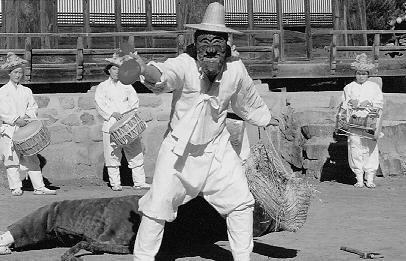|

 Hahoe Pyolshin-Gut T'al-nori is
a mask dance drama handed down by lower-class people in the Hahoe
Maeul, P'ungch'on-myon, Andong City, Kyongsangpuk-do since the
middle of the 12th century. Hahoe Maeul, as a Pungsan Ryu's consanguineous
village, has quite well preserved the life and culture of our
ancestors. Hahoe Pyolshin-Gut T'al-nori is
a mask dance drama handed down by lower-class people in the Hahoe
Maeul, P'ungch'on-myon, Andong City, Kyongsangpuk-do since the
middle of the 12th century. Hahoe Maeul, as a Pungsan Ryu's consanguineous
village, has quite well preserved the life and culture of our
ancestors.
The entire Village has been designated Important Folk Material
No. 122. Its topographical features resemble a floating lotus
upon the stream, and the Naktong river and the mountain range
surrounding the Village form the Taegeuk (Yin-Yang) symbol.
Its situation is not easily accessed by foreigners, for to the
east of it is located Hwasan and to the north, south, and west
is the enveloping Naktong river.
These geographically isolated conditions have rendered Hahoe Maeul
safe from foreign invasions several times.
Its magnificent natural surroundings had aroused very exuberant
feelings in the Village people, and thus had been an impulse in
the creation of the masterpiece of Hahoe Pyolshin-Gut T'al-nori.
Korean Mask Dance Drama is classified
as Sonang (the village shaman) Ritual Mask Dance and Sandae (the
mountainous stage) Mask Dance Drama. Hahoe Pyolshin-Gut T'al-nori
belongs to the former type, and to the comprehensive village ritual
of Pyolshin-Gut while
preserving its peculiar dramatic characteristics.
Village sacrificial rituals had been performed on January 15 and
April 8 (Buddha's birthday) of each year by the lunar calendar
in the Hahoe Maeul.
Seonghwangshin of the Village was called the goddess born in the
year of Mujin, and the annual ritual for this seonghwangshin was
Dongje (or Dangje i.e. Village Ritual).
Pyolshin-Gut T'al-nori together with Dongje had been performed
by an oracle (god-descending) every three, five, or ten years
when diseases or epidemic occurred in the village.
The structure of Pyolshin-Gut is composed of four parts including
god-descending, greeting god, pleasing god, and sending god. T'al-nori
belongs to the third part. That is, pleasing god was believed
to drive away disasters and to bring forth blessings for the village
people.
The quintessence of T'al-nori is to portray the conflicting relationship
between Yangban (ruling class) and Sangmin (ruled class) by disclosing
falsehood of Yangban and Sonbi (the then ruling classes). Additionally,
it reveals the depraved Buddhism in those days
through Chung i.e. a Buddhist Monk's violation of a commandment,
and satirically delineates the joys and sorrows of the ruled common
people. Likewise, the lower people of Hahoe Maeul had no reluctance
to satire the society and reveal their suppressed feelings.
T'al-nori, which criticized the ruling classes of the society
in which status and order were highly observed, was performed
under Yangban's tacit consent and financial support in Hahoe Maeul,
the Yangban Village.
The performance resulted in the harmonious life between upper
and lower classes, Yangban and Sangmin.
For it was possible for Sangmin to settle their oppressed feelings,
and for Yangban to understand their way of life and to reduce
their complaints. Thus, the conflicts and problems between classes
in the inner part of the community had passed through the shock-absorbing
process of T'al-nori performed as one of village rituals
of Pyolshin-Gut, and once more had the function to reinforce the
existing structural systems of the community.
The final Hahoe Pyolshin-Gut
T'al-nori was performed in 1928, and was restored to the
original state by the Research Society of the Hahoe Mask Dance
Drama in 1973. The Korean government designated this T'al-nori
as Important Intangible Cultural Property No. 69 on
November 1980.

Kangsin Madang Scene
 Kangsin (Invocation to a god)
represents prayers for a local god to descend at the local shrine.
Ringing bells on a god-descending tree symbolize the descendence
of the god. The other big tree hanging the bells becomes the divine
body of the local god, and only where the tree stops, can the
Hahoe Mask Dance Drama start. Kangsin (Invocation to a god)
represents prayers for a local god to descend at the local shrine.
Ringing bells on a god-descending tree symbolize the descendence
of the god. The other big tree hanging the bells becomes the divine
body of the local god, and only where the tree stops, can the
Hahoe Mask Dance Drama start.

Mudong Madang Scene
 Kakshi (The Young Girl) enters
"on the shoulders of a man" (Mudong). Kakshi is the
personification of the local goddess. Her frequent asking for
rice and money may be traced to a divine origin. Her actions ensure
virtues and blessings from the local goddess. Kakshi should never
touch the earth. She is always above the common people. Playing
the role of the local goddess is demontrated by always being carried
on the shoulders of a man. Kakshi (The Young Girl) enters
"on the shoulders of a man" (Mudong). Kakshi is the
personification of the local goddess. Her frequent asking for
rice and money may be traced to a divine origin. Her actions ensure
virtues and blessings from the local goddess. Kakshi should never
touch the earth. She is always above the common people. Playing
the role of the local goddess is demontrated by always being carried
on the shoulders of a man.

Chuji Madang Scene
 Chuji
signifies lions, and they sanctify the performing ground by driving
away demons and evil spirits. Chuji
signifies lions, and they sanctify the performing ground by driving
away demons and evil spirits.
Paekchong (The Butcher) Madang
Scene
 
Paekchong (The Butcher) has the instinct
to strike down a bull and remove its heart and testicles. After
that, Paekchong
satirizes the authoritative attitudes of the ruling class who
suppressed feelings toward sexuality. Paekchong makes fun of the
ruling class with his humorous speech. His actions cause the spectators
to laugh and be sympathetic as the act releases the ties of sexual
taboos.

 Halmi
(The Granny) Halmi
(The Granny)
Halmi (The Granny) exposes her
miserable life she has led since she became a widow when she was
15 years old by singing Beteulga (a song for a loom).
베틀가
춘아 춘아 옥단
춘아 성황당에 신령님네 시단춘이 춘이련가
시집간지 사흘만에 이런일이 또 있는가 열다섯살 먹은나이
과부될 줄 알았다면 시집갈년 누이런가 바디잡아 치는소리
일평생을 시집살이 아구답답 내 팔자야.

Chung (The Wandering Monk)
Madang Scene
 Pune
(The Flirtatious Girl) suddenly crouches and urinates. At that
instant, Chung (The Wandering Monk) is stirred by watching her.
They dance together and then are detected. This act satirizes
man's instinctive conflict and reveals the corrupted state of
the monks in those days. Pune
(The Flirtatious Girl) suddenly crouches and urinates. At that
instant, Chung (The Wandering Monk) is stirred by watching her.
They dance together and then are detected. This act satirizes
man's instinctive conflict and reveals the corrupted state of
the monks in those days.

 Yangban
(The Aristocrat) and Sonbi (The Scholar) take pride in their status
and knowledge in fighting to get Pune, the flirtatious girl. They
cease to quarrel and dance together with Pune. They will fight
again over buying the bull's testicles from Paekchong. They are
criticized by Halmi and exit at the sound of "give your tax". Yangban
(The Aristocrat) and Sonbi (The Scholar) take pride in their status
and knowledge in fighting to get Pune, the flirtatious girl. They
cease to quarrel and dance together with Pune. They will fight
again over buying the bull's testicles from Paekchong. They are
criticized by Halmi and exit at the sound of "give your tax".

The simple Honrye (wedding
ceremony) Madang Scene
 The
simple Honrye (wedding ceremony) takes place on a straw mat prepared
at a field near the entrance of a village after the sun sets.
This act discloses the first night in the bridal room. Sleeping
on the mat signifies fertility and productivity. It is generally
believed the pair will produce a son. The
simple Honrye (wedding ceremony) takes place on a straw mat prepared
at a field near the entrance of a village after the sun sets.
This act discloses the first night in the bridal room. Sleeping
on the mat signifies fertility and productivity. It is generally
believed the pair will produce a son.
(홀기) 신랑출 신부출 서동부서 서부서서 부선재배 서답일배
시자침주 예필~~

Shinbang (the bridal room)
Madang Scene
 This
act is held at midnight to keep alive the mood of the Shinbang
(the bridal room). Chonggak (The Bridegroom) approaches Kakshi
(The Bride) and loosens the knot of her upper wedding attire.
He then embraces her and they lie down. This
act is held at midnight to keep alive the mood of the Shinbang
(the bridal room). Chonggak (The Bridegroom) approaches Kakshi
(The Bride) and loosens the knot of her upper wedding attire.
He then embraces her and they lie down.

As below is Hahoe Village.

|



 Hahoe Pyolshin-Gut T'al-nori is
a mask dance drama handed down by lower-class people in the Hahoe
Maeul, P'ungch'on-myon, Andong City, Kyongsangpuk-do since the
middle of the 12th century. Hahoe Maeul, as a Pungsan Ryu's consanguineous
village, has quite well preserved the life and culture of our
ancestors.
Hahoe Pyolshin-Gut T'al-nori is
a mask dance drama handed down by lower-class people in the Hahoe
Maeul, P'ungch'on-myon, Andong City, Kyongsangpuk-do since the
middle of the 12th century. Hahoe Maeul, as a Pungsan Ryu's consanguineous
village, has quite well preserved the life and culture of our
ancestors. Kangsin (Invocation to a god)
represents prayers for a local god to descend at the local shrine.
Ringing bells on a god-descending tree symbolize the descendence
of the god. The other big tree hanging the bells becomes the divine
body of the local god, and only where the tree stops, can the
Hahoe Mask Dance Drama start.
Kangsin (Invocation to a god)
represents prayers for a local god to descend at the local shrine.
Ringing bells on a god-descending tree symbolize the descendence
of the god. The other big tree hanging the bells becomes the divine
body of the local god, and only where the tree stops, can the
Hahoe Mask Dance Drama start.  Kakshi (The Young Girl) enters
"on the shoulders of a man" (Mudong). Kakshi is the
personification of the local goddess. Her frequent asking for
rice and money may be traced to a divine origin. Her actions ensure
virtues and blessings from the local goddess. Kakshi should never
touch the earth. She is always above the common people. Playing
the role of the local goddess is demontrated by always being carried
on the shoulders of a man.
Kakshi (The Young Girl) enters
"on the shoulders of a man" (Mudong). Kakshi is the
personification of the local goddess. Her frequent asking for
rice and money may be traced to a divine origin. Her actions ensure
virtues and blessings from the local goddess. Kakshi should never
touch the earth. She is always above the common people. Playing
the role of the local goddess is demontrated by always being carried
on the shoulders of a man.


 Pune
(The Flirtatious Girl) suddenly crouches and urinates. At that
instant, Chung (The Wandering Monk) is stirred by watching her.
They dance together and then are detected. This act satirizes
man's instinctive conflict and reveals the corrupted state of
the monks in those days.
Pune
(The Flirtatious Girl) suddenly crouches and urinates. At that
instant, Chung (The Wandering Monk) is stirred by watching her.
They dance together and then are detected. This act satirizes
man's instinctive conflict and reveals the corrupted state of
the monks in those days.


